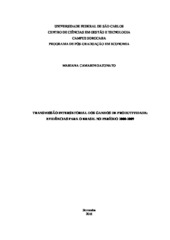| dc.contributor.author | Gazonato, Mariana Camarin | |
| dc.date.accessioned | 2016-12-06T10:21:23Z | |
| dc.date.available | 2016-12-06T10:21:23Z | |
| dc.date.issued | 2016-03-03 | |
| dc.identifier.citation | GAZONATO, Mariana Camarin. Transmissão intersetorial dos ganhos de produtividade: evidências para o Brasil no período 2000-2009. 2016. Dissertação (Mestrado em Economia) – Universidade Federal de São Carlos, Sorocaba, 2016. Disponível em: https://repositorio.ufscar.br/handle/ufscar/8334. | * |
| dc.identifier.uri | https://repositorio.ufscar.br/handle/ufscar/8334 | |
| dc.description.abstract | The main purpose of this dissertation is to analyze the capacity of sectors of the Brazilian economy to tranfer their productivity gains over the production chain, in the period 2000-2009. In this way, an adjustment is performed, through the structural decomposition technique of the input-output analysis of Dietzenbacher and Los (1998), of the method proposed by Greenhalgh e Gregory (2000). The fundamental assumptions, based on the structuralist current, are that the Industry tends to have larger increases in productivity and linkages with other segments of the economy, especially when compared to the Services. Together, these attributes would make that the productivity gains of the industrial sector propagate more intensely by the productive chain. The results show that in the period analyzed, the Agricultural and Services were the primarily responsible for transmiting these increments for the rest of the economy, instead of Industry, which moved forward losses of productivity. However, despite the Services have become more productive and transferred these gains over the production chain, the average transmission power of its segments was relatively low compared to the Industry's ability to transmit forward its productivity losses. This is because a considerable portion of the increments of the tertiary sector occurred in Personal Services, segment with reduced links in the production chain and whose goods meet, mainly, the individual consumer. The fact that the Industry ´s power transmission is, on average, higher than that of Services implies that if the industrial sector had increase its productivity, rather than decrease it, greater productivity gains would have been transmitted to the other segments of the economy that have been verified by the productivity gains of Services. However, it is important to stress that certain activities of the tertiary sector showed high potential to transfer these increments. This was the case of the Knowledge-Intensive Business Services. | eng |
| dc.description.sponsorship | Coordenação de Aperfeiçoamento de Pessoal de Nível Superior (CAPES) | por |
| dc.language.iso | por | por |
| dc.publisher | Universidade Federal de São Carlos | por |
| dc.rights.uri | Acesso aberto | por |
| dc.subject | Organização industrial (Teoria econômica) | por |
| dc.subject | Produtividade | por |
| dc.subject | Indústrias - Brasil | por |
| dc.subject | Ganhos de produtividade | por |
| dc.subject | Poder de transmissão | por |
| dc.subject | Transbordamentos intersetoriais | por |
| dc.subject | Economia de serviços | por |
| dc.subject | Economia industrial | por |
| dc.subject | Industrial organization (Economic theory) | por |
| dc.subject | Productivity | eng |
| dc.subject | industry - Brazil | eng |
| dc.subject | Productivity gains | eng |
| dc.subject | Power of transmission | eng |
| dc.subject | Intersectoral spillovers | eng |
| dc.subject | Service economy | eng |
| dc.subject | Industrial economy | eng |
| dc.title | Transmissão intersetorial dos ganhos de produtividade: evidências para o Brasil no período 2000-2009 | por |
| dc.title.alternative | Intersectoral transmission of productivity gains: evidence for Brazil in the period 2000-2009 | eng |
| dc.type | Dissertação | por |
| dc.contributor.advisor1 | Oliveira, Maria Aparecida Silva | |
| dc.contributor.advisor1Lattes | http://lattes.cnpq.br/3455553543736709 | por |
| dc.description.resumo | O objetivo principal desta dissertação é analisar a capacidade dos setores da economia brasileira de transferir seus ganhos de produtividade ao longo da cadeia produtiva, no período 2000-2009. Neste sentido, é realizada uma adaptação, por meio da técnica de decomposição estrutural da análise de insumo-produto de Dietzenbacher e Los (1998), do método proposto por Greenhalgh e Gregory (2000). As hipóteses fundamentais, baseadas na corrente estruturalista, são de que a Indústria tende a apresentar maiores incrementos de produtividade e relações de encadeamento com os demais segmentos da economia, especialmente quando comparadas aos Serviços. Juntos, tais atributos fariam com que com os ganhos de produtividade do setor industrial se espraiassem mais intensamente pela cadeia produtiva.Os resultados apontam que no período analisado,a Agropecuária e os Serviços foram os principais responsáveis por transmitirem este sincrementos para o restante da economia, em detrimento da Indústria, a qual transferiu para frente perdas de produtividade. No entanto, apesar dos Serviços terem se tornado mais produtivos e transferido estes ganhos ao longo da cadeia produtiva, o poder de transmissão médio dos seus segmentos mostrou-se relativamente baixo quando comparado à capacidade da Indústria transmitir para frente suas perdas de produtividade. Isto porque parcela considerável dos incrementos do setor terciário ocorreu nos Serviços Pessoais, segmento com reduzidos elos na cadeia produtiva e cujos bens atendem, majoritariamente, o consumidor individual. O fato do poder de transmissão da Indústria ser, na média,superior ao dos Serviços, implica que se o setor industrial tivesse elevado sua produtividade, ao invés de diminuí-la, maiores ganhos de produtividade teriam sido transbordados para os outros segmentos da economia do que foram verificados pelo aumento da produtividade dos Serviços. É importante ressaltar, no entanto, que determinadas atividades do setor terciário apresentaram elevado potencial de transferir estes incrementos. Este foi o caso dos Serviços Empresariais Intensivos em Conhecimento. | por |
| dc.publisher.initials | UFSCar | por |
| dc.publisher.program | Programa de Pós-Graduação em Economia - PPGEc-So | por |
| dc.subject.cnpq | CIENCIAS SOCIAIS APLICADAS::ECONOMIA::ECONOMIA INDUSTRIAL::ORGANIZACAO INDUSTRIAL E ESTUDOS INDUSTRIAIS | por |
| dc.ufscar.embargo | Online | por |
| dc.publisher.address | Câmpus Sorocaba | por |
| dc.contributor.authorlattes | http://lattes.cnpq.br/7648344630013089 | por |
